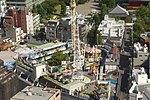Kaminarimon
AsakusaGates in JapanUse mdy dates from October 2011

The Kaminarimon (雷門, "Thunder Gate") is the outer of two large entrance gates that ultimately leads to the Sensō-ji (the inner being the Hōzōmon) in Asakusa, Tokyo, Japan. The gate, with its lantern and statues, is popular with tourists. It stands 11.7 m tall, 11.4 m wide and covers an area of 69.3 m2. The first gate was built in 941, but the current gate dates from 1960, after the previous gate was destroyed in a fire in 1865.
Excerpt from the Wikipedia article Kaminarimon (License: CC BY-SA 3.0, Authors, Images).Kaminarimon
花やしき通り, Taito Asakusa
Geographical coordinates (GPS) Address Phone number Website Nearby Places Show on map
Geographical coordinates (GPS)
| Latitude | Longitude |
|---|---|
| N 35.711111111111 ° | E 139.79638888889 ° |
Address
金龍山 浅草寺
花やしき通り 1
111-0032 Taito, Asakusa
Japan
Open on Google Maps











